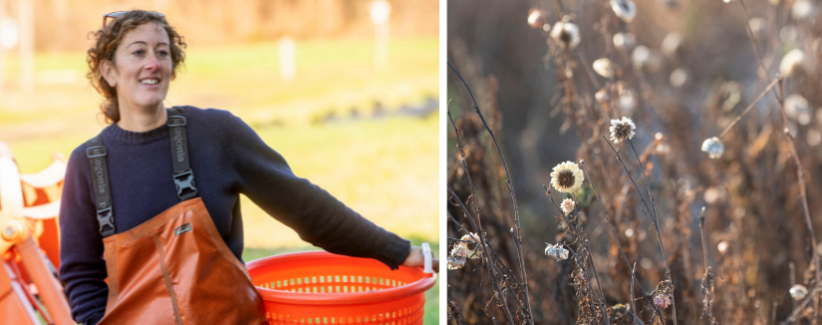Winter Reflections: Sharing Space

As we approach the winter solstice, time and space feel more expansive in a vegetable grower’s life. With the leaves now resting on the earth there is a sense of physical and mental vastness. I can see more clearly through the woods, the hardy juncos and bluebirds who overwinter suddenly appear on naked branches, and there is a gentleness and calmness to a farm draped with shades of browns, muted reds, and soft yellows. Daily life takes a slower pace with more sleep and heartier breakfasts accompanied by coffee in a hot ceramic mug.
As a farm manager, I can now begin to rest and reflect, accompanied by winter and its encroaching darkness. It’s been an intense and challenging year as a new manager and there is much to contemplate and much contentment to feel.
If there was ever an official end to a growing season, this time of year is it. In the past few weeks, we have harvested the last of our salad mixes, arugula, and mustard greens, winterized our field irrigation lines and wash station, received next year’s potting-soil order, and have spread as many leaves as we can to cover any bare ground. For the cover crops, the oats and field peas—which have been slowly dying as the nights drop below freezing—now act as a mulch that will be raked off in the spring before we seed the bed. The winter rye and crimson clover remain green and continue to photosynthesize, feeding the billions of life forms underneath the soil surface. In June, they will begin to flower and eventually become an in-place mulch for our fall broccoli, cabbages, and winter squashes.

Although the strong physical work has lessened, there is much planning to be done in preparation for the upcoming season. Just as in life, there is always more to do, more to dream up, and more to improve upon. In our no-till intensive system, it’s all in the planning. It’s important to plan out each bed so that we can maintain plants growing at all times and keep the soil covered as much as possible. Most of our field plots are double-cropped and some are even triple-cropped, meaning we will plant a succession of three different crops on the same piece of earth throughout our growing season, which runs roughly March through December.
For me, my time these next couple months will be spent reviewing the past season’s crop plan, altering it according to what worked well, what didn’t, and how our recipients responded to the amounts and kinds of crops we gave them, and then mapping out how each planting fits together within time and through space. It’s also a time when we order seeds, fertilizer and amendments, and any equipment we need. We spend time fixing and maintaining our tools, organizing, and cleaning our space. We hire the crew for the coming season, gather and split firewood, attend conferences and deepen our learning of agricultural techniques, and research pests and diseases. It’s a time to connect with other farmers, family, and friends.
The growth from this intense summer still lingers within me as I continue to reflect on our collective learning. For me, I have been investigating the meaning of reciprocity and how this should be reflected in our stewardship of land, water, and air.
What is the true meaning of reciprocity in our daily life? And how can it exist in a world that values consumption and such unrestrained growth? How do we truly care for life and what are the actions we must take for this to be a healthy balance of giving and receiving?

I have a deep appreciation for this natural world we are all a part of and for the immense learning that each year brings. Every season I am reminded of the interconnectedness of the world and how, when one thrives, then we all do: It is shared. I have learned about the power of collaboration this season and how again we must look to Mother Nature’s way of communicating. It is supportive and holistic. Themes of observation and listening foster a sense of curiosity in the community of life around me. We all exist in the same ecosystem and we all have an important role to play within it.
I am grateful for the opportunity to be a worker of the land and am slowly coming home to my own answers as I ask these questions aloud. I am finding meaning and answers in my neighbors, like the brilliant bluebirds and the maple trees that offer us sweet sap at just the right time. I find meaning in the pause, to be satisfied with the present, to appreciate the good in the world. I am observing and listening, learning the language of this part of the world, this community.
For whomever is reading this, I hope you too have time and space within your life to deeply reflect on where you have been, where you are, and where you might be heading. I wish you the energy and curiosity to get to know your neighbors and take time to listen, observe your home, your community. And to examine what the act of reciprocity looks like in your own life and to simply share food as gifts from the earth with loved ones. Happy winter solstice, let there be light within you.